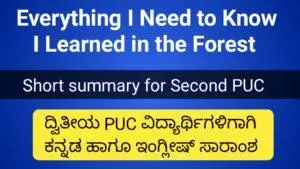
Everything I Need to Know I Learned in the Forest summary in Kannada and English for second PUC. PUC second year notes.
In this post we will learn Kannada summary of Everything I Need to Know I Learned in the Forest. Important notes of Everything I Need to Know I Learned in the Forest.
To get more video notes for 2nd PUC visit our YouTube channel. This channel is very useful for PUC second year exam preparation.
Everything I Need to Know I Learned in the Forest summary in Kannada
ಚಿಪ್ಕೋ ಚಳುವಳಿ:
ಹಿಮಾಲಯ ಪ್ರದೇಶದಲ್ಲಿನ ದೊಡ್ಡ ಪ್ರಮಾಣದ ಅರಣ್ಯನಾಶಕ್ಕೆ ಇದು ಅಹಿಂಸಾತ್ಮಕ ಪ್ರತಿಕ್ರಿಯೆಯಾಗಿದೆ. 1970ರ ದಶಕದಲ್ಲಿ ಹಿಮಾಲಯದ ಗರ್ವಾಲಿಯಲ್ಲಿದ್ದ ರೈತ ಮಹಿಳೆಯರು ಅರಣ್ಯ ರಕ್ಷಣೆಗೆ ಮುಂದಾಗಿದ್ದರು. ವಂದನಾ ಶಿವ ಈ ಪ್ರದೇಶದಲ್ಲಿ ಕಾಡುಗಳ ನಿರಂತರ ನಷ್ಟವನ್ನು ಗಮನಿಸಿದರು. ಅವರು ಆಂದೋಲನಕ್ಕೆ ಸ್ವಯಂಸೇವಕರಾಗಲು ನಿರ್ಧರಿಸಿದರು.
ಜೈವಿಕ ವೈವಿಧ್ಯ – ನವದಾನ್ಯ ಫಾರ್ಮ್:
ಚಿಪ್ಕೋ ಚಳುವಳಿ ವಂದನಾ ಶಿವ ಅವರಿಗೆ ಜೀವವೈವಿಧ್ಯದ ಬಗ್ಗೆ ಕಲಿಸಿತು. ಜೀವವೈವಿಧ್ಯ ಆಧಾರಿತ ಜೀವನ ಆರ್ಥಿಕತೆಯ ಮಹತ್ವವನ್ನು ಅವರು ಅರಿತುಕೊಂಡರು. ಅವರು 1987 ರಲ್ಲಿ ಜೀವವೈವಿಧ್ಯ ಸಂರಕ್ಷಣೆ ಮತ್ತು ಸಾವಯವ ಕೃಷಿಗಾಗಿ ನವದಾನ್ಯವನ್ನು ಪ್ರಾರಂಭಿಸಿದರು. ವಂದನಾ ಶಿವ ಅವರು ಭಾರತದಾದ್ಯಂತ 100 ಕ್ಕೂ ಹೆಚ್ಚು ಸಮುದಾಯ ಬೀಜ ಬ್ಯಾಂಕ್ಗಳನ್ನು ಸ್ಥಾಪಿಸಲು ರೈತರೊಂದಿಗೆ ಕೆಲಸ ಮಾಡಿದ್ದಾರೆ. ಅವರು 3000 ಕ್ಕೂ ಹೆಚ್ಚು ಅಕ್ಕಿ ತಳಿಗಳನ್ನು ಉಳಿಸಿದ್ದಾರೆ. ಇದು ಏಕಸಂಸ್ಕೃತಿಯಿಂದ ಜೈವಿಕ-ವೈವಿಧ್ಯ ಪರಿಸರ ವ್ಯವಸ್ಥೆಗಳಿಗೆ ಪರಿವರ್ತನೆಯಾಗಿದೆ.
ತನ್ನ ಪ್ರಯೋಗವನ್ನು ಪ್ರದರ್ಶಿಸಲು, ಅವರು 1994 ರಲ್ಲಿ ಉತ್ತರಾಖಂಡ ಪ್ರಾಂತ್ಯದ ಕಡಿಮೆ ಎತ್ತರದ ಹಿಮಾಲಯ ಪ್ರದೇಶದ ಡೂನ್ ಕಣಿವೆಯಲ್ಲಿ ನವದಾನ್ಯ ಫಾರ್ಮ್ ಅನ್ನು ಪ್ರಾರಂಭಿಸಿದರು. ಅವರು ಈಗ 630 ವಿಧದ ಅಕ್ಕಿ, 150 ವಿಧದ ಗೋಧಿ ಮತ್ತು ನೂರಾರು ಇತರ ಜಾತಿಗಳನ್ನು ಸಂರಕ್ಷಿಸಲು ಮತ್ತು ಬೆಳೆಯಲು ಸಮರ್ಥರಾಗಿದ್ದಾರೆ. ಹೀಗಾಗಿ ಅವರು ಪ್ರತಿ ಎಕರೆಗೆ ಹೆಚ್ಚು ಆಹಾರ ಮತ್ತು ಪೋಷಣೆಯನ್ನು ಉತ್ಪಾದಿಸುವ ಜೈವಿಕ ವೈವಿಧ್ಯತೆಯ ತೀವ್ರ ಸ್ವರೂಪದ ಕೃಷಿಯನ್ನು ಅಭ್ಯಾಸ ಮಾಡುತ್ತಾರೆ ಮತ್ತು ಉತ್ತೇಜಿಸುತ್ತಾರೆ.
ಪ್ರಕೃತಿಯ ಹಕ್ಕುಗಳು:
ಈಕ್ವೆಡಾರ್ನ ಸಂವಿಧಾನ ಮತ್ತು ಬೊಲಿವಿಯಾ ಆರಂಭಿಸಿದ ಭೂಮಿ ತಾಯಿಯ ಹಕ್ಕುಗಳ ಸಾರ್ವತ್ರಿಕ ಘೋಷಣೆಯಿಂದ ಸ್ಫೂರ್ತಿ ಪಡೆದ ಭೂ ದಿನಾಚರಣೆಯ ಅಂಗವಾಗಿ ಯುಎನ್ ಜನರಲ್ ಅಸೆಂಬ್ಲಿಯು ಪ್ರಕೃತಿಯೊಂದಿಗೆ ಸಾಮರಸ್ಯದ ಸಮಾವೇಶವನ್ನು ಹೇಗೆ ಆಯೋಜಿಸಿದೆ ಎಂಬುದರ ಕುರಿತು ವಂದನಾ ಶಿವ ಆಸಕ್ತಿದಾಯಕವಾಗಿ ಮಾತನಾಡಿದ್ದಾರೆ. ಇದು ಪ್ರಕೃತಿಯ ಮೇಲೆ ಮಾನವ ಪ್ರಾಬಲ್ಯದ ವಿರುದ್ಧ ಭೂಮಿ ತಾಯಿಗೆ ಅಂಟಿಕೊಂಡಿರುವ ಮಹತ್ವವನ್ನು ಒತ್ತಿಹೇಳುತ್ತದೆ. ಮಾನವರು ಪ್ರಕೃತಿಯ ಅವಿಭಾಜ್ಯ ಅಂಗ ಎಂಬ ದೃಷ್ಟಿಕೋನವನ್ನು ಅವ ರು ಎತ್ತಿ ಹಿಡಿಯುತ್ತಾರೆ. ಆದ್ದರಿಂದ, ಒಂದು ಕಾಲದಲ್ಲಿ ಜನರನ್ನು ಬಣ್ಣಗಳ ಆಧಾರದ ಮೇಲೆ ವಿಭಜಿಸುವ ವರ್ಣಭೇದ ನೀತಿ ಇಂದು ನಮಗೆ ಅಗತ್ಯವಿಲ್ಲ ಎಂದು ಅವರು ಭಾವಿಸುತ್ತಾರೆ. ಪ್ರಕೃತಿಯಿಂದ ಮಾನವರ ಪ್ರತ್ಯೇಕತೆಯ ಆಧಾರದ ಮೇಲೆ ಪರಿಸರ ವರ್ಣಭೇದ ನೀತಿಯನ್ನು ಜಯಿಸುವುದು ನಮ್ಮ ಸವಾಲು.
Important notes of Everything I Need to Know I Learned in the Forest
ಡೆಡ್ ಅರ್ಥ್ / ಕೈಗಾರಿಕಾ ಕ್ರಾಂತಿ:
ಈ ಪ್ರತ್ಯೇಕತೆಯು ರೋಮಾಂಚಕ ಭೂಮಿಯನ್ನು ಬದಲಿಸುವ ಮತ್ತು ಅದನ್ನು ಸತ್ತ ವಸ್ತುವಾಗಿ ಪರಿವರ್ತಿಸುವ ಕೈಗಾರಿಕಾ ಕ್ರಾಂತಿಗೆ ದಾರಿ ಮಾಡಿಕೊಟ್ಟಿತು. ಇದು ಬಂಡವಾಳಶಾಹಿ ಮತ್ತು ಗ್ರಾಹಕೀಕರಣಕ್ಕೆ ಕಾರಣವಾಯಿತು, ಇದು ನೈಸರ್ಗಿಕ ಸಂಪನ್ಮೂಲಗಳನ್ನು ವಿವೇಚನೆಯಿಲ್ಲದೆ ಬಳಸಿಕೊಳ್ಳುತ್ತದೆ. ಹೀಗಾಗಿ ಟೆರ್ರಾ ಮಾಡ್ರೆ (ಮದರ್ ಅರ್ಥ್) ಅನ್ನು ಟೆರ್ರಾ ನುಲಿಯಸ್ (ಖಾಲಿ ಭೂಮಿ / ಸತ್ತ ಭೂಮಿ) ನಿಂದ ಬದಲಾಯಿಸಲಾಯಿತು.
ಭೂಮಿಯ ವಿಶ್ವವಿದ್ಯಾಲಯ:
ನವದಾನ್ಯ ಜೀವವೈವಿಧ್ಯ ಫಾರ್ಮ್ನಲ್ಲಿರುವ ಅರ್ಥ್ ವಿಶ್ವವಿದ್ಯಾನಿಲಯವು ಭೂಮಿಯ ಪ್ರಜಾಪ್ರಭುತ್ವವನ್ನು ಕಲಿಸುವ ರವೀಂದ್ರನಾಥ ಟ್ಯಾಗೋರ್ರಿಂದ ಸ್ಫೂರ್ತಿಯಾಗಿದೆ; ಇತರ ಜಾತಿಗಳ ಹಕ್ಕುಗಳನ್ನು ಗುರುತಿಸಲು, ರಕ್ಷಿಸಲು ಮತ್ತು ಗೌರವಿಸಲು. ಇದು ಮಾನವಕೇಂದ್ರಿತದಿಂದ (ಮಾನವ ಕೇಂದ್ರಿತ) ಅಹಂಕೇಂದ್ರಿತಕ್ಕೆ (ಪ್ರಕೃತಿ ಕೇಂದ್ರಿತ) ಬದಲಾವಣೆಯಾಗಿದೆ.
ಅರಣ್ಯ ಮತ್ತು ಸ್ವಾತಂತ್ರ್ಯ:
ಈ ಪ್ರಬಂಧದ ಕೊನೆಯ ವಿಭಾಗವು “ಪುನರುತ್ಥಾನ” ದ ಮೇ / ಜೂನ್ 2011 ರ ಆವೃತ್ತಿಯಲ್ಲಿ ಪ್ರಕಟವಾದ ವಂದನಾ ಶಿವ ಬರೆದ “ಅರಣ್ಯ ಮತ್ತು ಸ್ವಾತಂತ್ರ್ಯ” ದಿಂದ ಅಳವಡಿಸಲಾಗಿದೆ. ಇದು ಟ್ಯಾಗೋರ್ ಅವರ ಅರಣ್ಯವನ್ನು ಕಲೆಯ ಸೌಂದರ್ಯ ಮತ್ತು ಸಂತೋಷದ ಮೂಲವಾಗಿ ಮತ್ತು ಸಾಮರಸ್ಯ ಮತ್ತು ಪರಿಪೂರ್ಣತೆಯ ಸೌಂದರ್ಯದ ಮೂಲವಾಗಿ ತೋರಿಸುತ್ತದೆ. ಅರಣ್ಯವು ನಮಗೆ ಒಕ್ಕೂಟ, ಸಹಾನುಭೂತಿ ಮತ್ತು ಸಹಿಷ್ಟುತೆಯನ್ನು ಕಲಿಸುತ್ತದೆ. ಇದು ನಮಗೆ ತ್ಯಾಗದ ಮೂಲಕ ಆನಂದವನ್ನು ಕಲಿಸುತ್ತದೆ ಮತ್ತು ಸ್ವಾಧೀನದ ದುರಾಸೆಯಿಂದಲ್ಲ. ಹೀಗಾಗಿ ಈ ಘರ್ಷಣೆಯನ್ನು ಮೀರಿದ ದಾರಿಯನ್ನು ನಮಗೆ ತೋರಿಸಬಲ್ಲದು ಈ ಕಾಡು ಎಂದು ವಂದನಾ ಶಿವ ತೀರ್ಮಾನಿಸುತ್ತಾರೆ.
Everything I Need to Know I Learned in the Forest summary in English
Chipko Movement:
It was a nonviolent response to the large scale deforestation in the Himalaya region. In the 1970s peasant women in the Garhwali, Himalaya had come out in defence of the forests. Vandana Shiva noticed a steady loss of forests in this region. She decided to become a volunteer for the movement.
Bio-diversity – Navadanya Farm:
Chipko Movement taught Vandana Shiva about biodiversity. She started Navadanya, the movement for biodiversity conservation and organic farm in 1987. Vandana Shiva has worked with farmers to set up more than 100 community seed banks across India. They have saved more than rice 3000 varieties. This is a transition from monocultures to bio-diverse ecological systems.
She started Navadanya Farm in 1994 in the Doon Valley in the lower elevation Himalayan region of Uttarakhand Province. They are now able to conserve and grow 630 varieties of rice, 150 varieties of wheat and hundreds of other species. Thus they practise and promote a biodiversity intensive form of farming that produces more food and nutrition per acre.
Rights of Nature:
Vandana Shiva interestingly talks about how the UN General Assembly organized a conference on harmony with nature as part of Earth Day celebrations inspired by the constitution of Ecuador and the Universal Declaration of the Rights of Mother Earth initiated by Bolivia. This emphasises the significance attached to the mother earth much against human domination over nature. She upholds the view that human beings are an inseparable part of nature. So, she feels that today, we do not need an apartheid situation which once divided people based on colour.
everything i need to know i learned in the forest notes
The Dead Earth / Industrial Revolution:
This separateness paved way to industrial revolution replacing vibrant earth and turning it into a dead matter. This has further led to Capitalism and Consumerism which exploit natural resources indiscriminately. Thus Terra Madre (Mother Earth) was replaced by Terra Nullius (the empty land / the dead earth).
The Earth University:
The Earth University located at Navadanya biodiversity farm is an inspiration from Rabindranath Tagore which teaches Earth Democracy; to recognize, protect and respect the rights of other species. It is a shift from anthropocentricism (human centric) to egocentrism (nature centric).
Forest and Freedom:
The last section of this essay is adapted from “Forest and Freedom” written by Vandana Shiva published in the May / June 2011 edition of “Resurgence”. This highlights Tagore’s view of forest as the source of beauty and joy of art and aesthetics of harmony and perfection. The forest teaches us union, compassion and enoughness. It teaches us enjoyment through renunciation and not through greed of possession. Thus Vandana Shiva concludes that it is this forest that can show us the way beyond this conflict.
Watch this video for the explanation of the lesson Everything I Need to Know I Learned in the Forest summary in Kannada and English for second PUC. PUC second year notes.
Part 1 summary:
Part 2 summary: